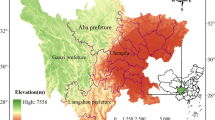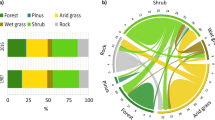Abstract
Peri-urban Mediterranean landscapes preserve high-quality environments with biodiversity strictly dependent on relict forests and mixed agroforest systems. The assessment of long-term land-use changes at the urban-wildland interface is particularly interesting for policies coping with natural land conservation and management. The dynamics of Mediterranean fringe forests were rather mixed over the last century alternating decline due to deforestation and clear-cutting up to World War II and a recovery afterwards. Forest transition theory (FTT) has been used to describe a turnaround in land-use trends for a given territory from a period of net forest area loss to a period of net forest area gain. The present paper analyses forest expansion in Rome’s province in the light of the FTT using diachronic maps, which cover two time intervals (1936–1974 and 1974–2006) corresponding to distinct socioeconomic contexts at the local scale. Our results indicate a slight increase in forest areas along the whole study period owing to natural reforestation following the abandonment of agricultural land and the higher level of forest protection. Geographically weighted regression indicates the growing importance of the urban gradient in forest dynamics. This may reflect settlement dispersion and higher disturbance to forests due to soil sealing, wildland fires, habitat fragmentation, cropland abandonment, and invasive species increase. The tendency towards a more mixed and heterogeneous woodland structure at the urban-wildland interface, especially in coastal areas, should be contrasted through sustainable land management practices integrating urban planning and environmental policies into a unique strategy for the protection of relict agroforest systems.



Similar content being viewed by others
References
Antrop M (2000) Changing patterns in the urbanized countryside of Western Europe. Landsc Ecol 15:257–270
Antrop M (2004) Landscape change and the urbanization process in Europe. Landsc Urb Plan 67:9–26
Attorre F, Bruno M, Francesconi F, Valenti R, Bruno F (2000) Landscape changes of some through tree-lined roads. Landsc Urb Plan 49:115–128
Baptista SR, Rudel TK (2006) A re-emerging Atlantic forest? Urbanization, industrialization and the forest transition in Santa Catarina, southern Brazil. Environ Conserv 33(3):195–202
Barbier EB, Burgess JC, Grainger A (2009) The forest transition: towards a more comprehensive theoretical framework. L Use Policy 27(2):98–107
Basso B, De Simone L, Ferrara A, Cammarano D, Cafiero G, Mei-Ling Y, Tien-Yin C (2010) Analysis of contributing factors to desertification and mitigation measures in Basilicata region. Ital J Agron 3:33–44. doi:10.4081/ija.2010.s3.33
Blondel J, Aronson J, Bodiou JY, Boeuf G (2010) The Mediterranean region. Biological diversity in space and time. Oxford University Press, Oxford
Cakir G, Un C, Baskent EZ, Kose S, Sivrikaya F, Keles S (2008) Evaluating urbanization, fragmentation and land use/cover change pattern in Istanbul city, Turkey from 1971 to 2002. L Degrad Dev 19:663–675
Catalàn B, Sauri D, Serra P (2008) Urban sprawl in the Mediterranean? Patterns of growth and change in the Barcelona Metropolitan Region 1993–2000. Landsc Urb Plan 85:174–184
Cavallo A, Marino D (2012) Understanding changing in traditional agricultural landscapes: towards a framework. J Agric Sci Technol 2:971–987
Falcucci A, Maiorano L, Boitani L (2007) Changes in land-use/land-cover patterns in Italy and their implications for biodiversity conservation. Landsc Ecol 22:617–631
Ferrara A, Salvati L, Sabbi A, Colantoni A (2014) Soil resources, land cover changes and rural areas: towards a spatial mismatch? Sci Total Environ 478:116–122. doi:10.1016/j.scitotenv.2014.01.040
Foley JA, DeFries R, Asner GP, Barford C, Bonan G, Carpenter SR, Chapin FS, Coe MT, Daily GC, Gibbs HK, Helkowski JH, Holloway T, Howard EA, Kucharik CJ, Monfreda C, Patz JA, Prentice IC, Ramankutty N, Snyder PK (2005) Global consequences of land use. Science 309:570–574
Fotheringham AS, Brunsdon C, Charlton M (2002) Geographically weighted regression: the analysis of spatially varying relationships. Wiley, London
Grainger A (1995) The forest transition: an alternative approach. Area 27(3):242–251
Kauppi PE, Ausubel JH, Fang J, Mather AS, Sedjo AR, Waggoner PE (2006) Returning forests analyzed with the forest identity. Proc Natl Acad Sci USA 103(46):17574–17579
Lang HR, Xu J (2014) Local dynamics driving forest transition: insights from upland villages in southwest China. Forests 5(2):214–233
Mancino G, Nolè A, Ripullone F, Ferrara A (2014) Landsat TM imagery and NDVI differencing for vegetation change detection: assessing natural expansion of forests in Basilicata, southern Italy. IForest 7:75–84. doi:10.3832/ifor0909-007
Mather AS (2004) Forest transition theory and the reforesting of Scotland. Scott Geogr J 120:83–98
Mather AS, Fairbairn J (2000) From floods to reforestation: the forest transition in Switzerland. Environ Hist 6(4):399–421
Mather AS, Needle CL (1998) The forest transition: a theoretical basis. Area 30(2):117–124
Mather AS, Needle CL, Coull JR (1998) From resource crisis to sustainability: the forest transition in Denmark. Int J Sust Dev World 5(3):182–193
Mather AS, Fairbairn J, Needle CL (1999) The course and drivers of the forest transition: the case of France. J Rural Stud 15(1):65–90
Meyfroidt P, Lambin EF (2011) Global forest transition: prospects for an end to deforestation. Annu Rev Environ Res 36:343–371
Moretti V, Ferrara A, Colantoni A, Carlucci M, Salvati L (2014) Forest transition and changes in the socio-economic structure of a developed country: a long-term analysis. Mod Econ 5:932–938. doi:10.4236/me.2014.59086
Munafò M, Norero C, Sabbi A, Salvati L (2010) Soil sealing in the growing city: a survey in rome italy. Scott Geogr J 126(3):153–161
Nolè A, Collalti A, Magnani F, Duce P, Ferrara A, Mancino M, Marras M, Sirca S, Spano D, Borghetti M (2013) Assessing temporal variation of primary and ecosystem production in two Mediterranean forests using a modified 3-PG model. Ann For Sci 70:729–741. doi:10.1007/s13595-013-0315-7
Nowak DJ, Walto JT, Dwyer JF, Kaya LG, Myeong S (2005) The increasing influence of urban environments on US forest management. J For 103:377–382
Pagnutti C, Bauch CT, Anand M (2013) Outlook on a worldwide forest transition. PLoS One 8(10):e75890
Perz SG (2007) Grand theory and context-specificity in the study of forest dynamics: forest transition theory and other directions. Prof Geogr 59(1):105–114
Plieninger T, Schaich H, Kizos T (2011) Land-use legacies in the forest structure of silvopastoral oak woodlands in the Eastern Mediterranean. Reg Environ Change 11:603–615
Redo DJ, Graub HR, Aidea TM, Clark ML (2012) Asymmetric forest transition driven by the interaction of socio-economic development and environmental heterogeneity in Central America. Proc Natl Acad Sci USA 109(23):8839–8844
Rodríguez LG, Pérez MR (2013) Recent changes in Chinese forestry seen through the lens of Forest Transition theory. Int For Rev 15(4):456–470
Rudel TK (1998) Is there a forest transition? Deforestation, reforestation, and development. Rural Sociol 63(4):533–552
Rudel TK, Coomes OT, Moran E, Achard F, Angelsen A, Xu J, Lambin E (2005) Forest transitions: towards a global understanding of the land use change. Glob Environ Change 15:23–31
Salvati L (2012) Urban expansion and high-quality soil consumption - an inevitable spiral? Cities 31:349–356
Salvati L, Ferrara A (2014) Do land cover changes shape sensitivity to forest fires in peri-urban areas? Urb For Urb Green 13(3):571–575. doi:10.1016/j.ufug.2014.03.004
Salvati L, Sabbi A (2011) Exploring long-term land cover changes in an urban region of southern Europe. Int J Sustain Dev World Ecol 18(4):273–282
Salvati L, Venezian Scarascia ME, Zitti M, Ferrara A, Urbano V, Sciortino M, Giupponi C (2009) The integrated assessment of land degradation. Ital J Agron 4(3):77–90. doi:10.4081/ija.2009.3.77
Salvati L, Sateriano A, Bajocco S (2013) To grow or to sprawl? Evolving land cover relationships in a compact mediterranean city region. Cities 30:113–121
Scarascia-Mugnozza G, Oswald H, Piussi P, Radoglou K (2000) Forest of the Mediterranean region: gaps in knowledge and research needs. For Ecol Manag 132:97–109
Sirami C, Nespoulous A, Cheylan JP, Marty P, Hvenegaard GT, Geniez P, Schatz B, Martin JL (2010) Long-term anthropogenic and ecological dynamics of a Mediterranean landscape: impacts on multiple taxa. Landsc Urb Plan 96:214–223
Stewart SI, Radeloff VC, Hammer RB, Hawbaker TJ (2007) Defining the Wildland-Urban Interface. J For 105(4):201–207
Theobald DM, Romme WH (2007) Expansion of the US wildland– urban interface. Landsc Urb Plan 83:340–354
Vince SW, Duryea ML, Macie EA, Hermansen LA (2005) Forests at the wildland–urban interface: conservation and management. CRC Press, Boca Raton
Yackulic CB, Fagan M, Jain M, Jina A, Lim Y, Marlier M, Muscarella R, Adame P, DeFries R, Uriarte M (2011) Biophysical and socio-economic factors associated with forest transitions at multiple spatial and temporal scales. Ecol Soc 16(3):1–22
Zipperer WC (2002) Species composition and structure of regenerated and remnant forest patches within an urban landscape. Urb Ecosyst 6:271–290
Author information
Authors and Affiliations
Corresponding authors
Additional information
This peer-reviewed article is a result of the multidisciplinary project coordinated by the “Accademia Nazionale delle Scienze detta dei XL”, Rome, Italy, in the area of the Presidential Estate of Castelporziano near Rome.
Rights and permissions
About this article
Cite this article
Salvati, L., Biasi, R., Carlucci, M. et al. Forest transition and urban growth: exploring latent dynamics (1936–2006) in Rome, Italy, using a geographically weighted regression and implications for coastal forest conservation. Rend. Fis. Acc. Lincei 26 (Suppl 3), 577–585 (2015). https://doi.org/10.1007/s12210-015-0378-5
Received:
Accepted:
Published:
Issue Date:
DOI: https://doi.org/10.1007/s12210-015-0378-5




